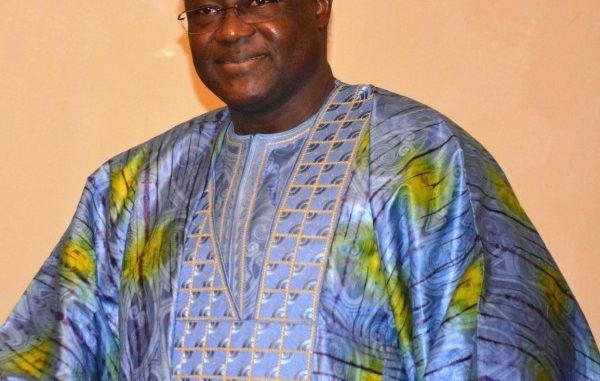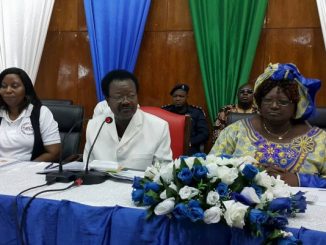
John Baimba Sesay & Sheriff Mahmud Ishmail
A news release last week by State House Communication Unit disclosed that President
Koroma on Friday 12th February was presented at State House with an inquiry report
on what the release describes as the “failed West Africa Regional Fisheries Programme
(WARFP)…” Although the release did not spell out what led to the failure of the project,
observers say the problems include low capacity of the project management team,
inadequate supervision and integrity issues.
The inquiry has therefore been applauded by many as timely and a worthy
demonstration of the Government’s determination to ensure accountability for any
wrongdoings.
The release by the State House Communication could not have been more apt: the
President “assured that the report will be looked at closely and recommendations
thereof will be implemented to the fullest.” and this includes the involvement of the Anti
Corruption Commission.
This proactive and decisive move by the presidency in dealing with the problems of
WARFP-SL has no doubt strengthened the relationship between the World Bank (which
funds the project) and the government of Sierra Leone much as it has restored the
Bank’s confidence in investing in the country’s fisheries sector.
While recommendations from the inquiry were being looked into, just last week the
World Bank announced that it will provide $4 million for a new fisheries project.
Analysts say the World Bank’s decision did not come as a surprise. The World Bank
supports over 15 active projects in the country with a portfolio of over $450 million.
Therefore the failure of just one project should not be over dramatized or sour relations
between the Bank and it’s client.
Sierra Leone’s 300 kilometer long coastline has an impressive continental shelf which
benefits from the country’s many rivers and huge amount of rainfall. These factors have
contributed to Sierra Leone’s rich marine fisheries which include shrimp, lobsters and a
colourful variety of fish like cuttlefish, snapper, grouper, catfish, herrings, tuna and
baracuda. All of these species have well established global markets with high prices.
But analysts say Sierra Leone’s marine investments potential has largely been
untapped.
Even under the current circumstance, the fisheries sector is believed to be contributing
about 10% to the country’s GDP, providing employment for an estimated 100,000
people directly and, indirectly for about 500, 000 people. This represents about 10% of
the country’s population. Coastal areas like Bonthe, Shenge, and Tombo etc- are
predominantly fishing communities with about 25% of the male population of working
age reported to be involved in part-time or full time fishing. This speaks volume of how
crucial the sector is to the country’s growth.
Sadly, the economic reality and investment potential of the fisheries sector has been
fraught with its own unique challenges. Destructive fishing gears and inshore shrimps
trawling practices as well as nets with tiny mesh sizes are damaging susceptible nursing
grounds and capturing baby fish.
Besides, fish products from Sierra Leone are not certified to be sold in the European
fish market owing to issues relating to standards and institutional capacity such as
landing sites with basic infrastructure for prevention of fish product contamination. This
limited the country’s participation in international fish trade and undercut the revenue
potential of the sector.
Illegal fishing and lack of value addition are also major setbacks, as major catch by
industrial vessels gets transshipped at sea for export.
By 2011, the Government of Sierra Leone, desirous to strengthen the management of
its marine resources, sought the support of the World Bank to reform the country’s
fisheries governance. The World Bank intervention came through a US$ 28 million to
project which was part of the West African Regional Fisheries Programme-WARFP-SL.
WARFP covers Senegal, Liberia, Sierra Leone and Cape Verde.
In Sierra Leone, the major objectives of the programme were to strengthen the capacity
of the country to effectively manage its fisheries, reduce illegal fishing and increase
local value addition.
To achieve these objectives within a five year period, the project was to establish a
number of Territorial Use Rights Fisheries (TURFs) in targeted coastal fisheries;
establish clear principles and policies aimed at increasing the wealth from fisheries by
strengthening rights of fishing communities and the equitable allocation of these rights,
strengthen and modernize the overall regulatory framework for industrial fishing,
establish a certified public laboratory and competent sanitary authority to facilitate the
process of gaining access to the international fish market.
Artisanal fishing communities were to be targeted by supporting full registration and
licensing of all fishing vessels and fishing gears in use. Also, fishing communities were
to empower to co-manage their marine resources through the introduction of Marine
Protected Areas (MPAs) that would have evolved into the Territorial User Rights
Fisheries (TURFs).
To reduce illegal, unregulated and unreported fishing, the project was to strengthen the
sector’s Monitoring, Control and Surveillance (MCS) systems to ensure industrial fishing
operations are carried out within the provisions of the country’s laws.
These reforms were expected to result in an increase in the contribution of the marine
fish resources to the local economy, increase the economic profitability and
environmental sustainability of the fisheries resources in Sierra Leone.
Illegal fishing alone accounts for an estimated $30 million revenue loss annually for the
country which authorities say ’’is totally unacceptable to the government.”
Clearly, WARFP-SL was supposed to have been a vital boost to Sierra Leone’s
economy. But even before the end of its five years of operation, the project which was
designed to improve the management of the country’s fisheries had crumbled under its
own management problems.
There are high hopes that the new project will succeed given the stringent
administrative actions being taken and the experiences it would draw from its
predecessor.




